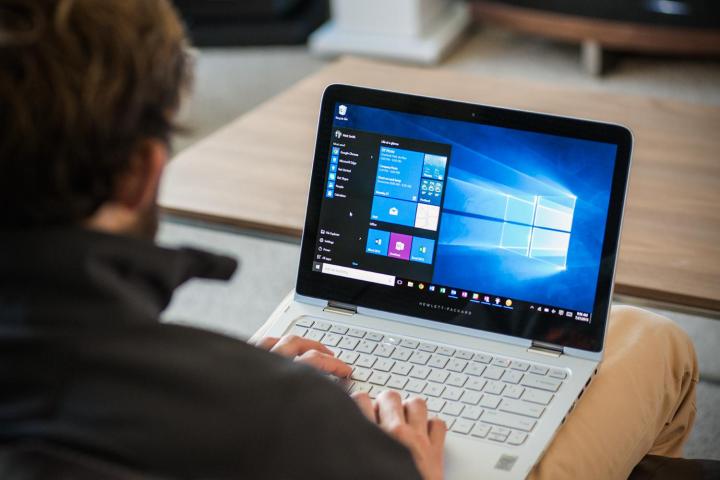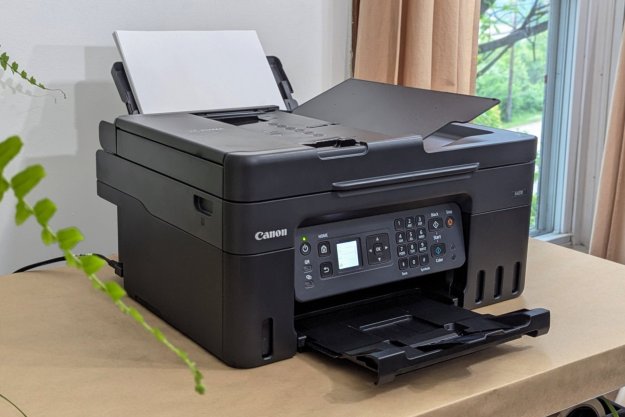
Connecting your printer automatically
For the average user, connecting a printer in Windows should be a snap, especially since the streamlined process relies mostly on auto-detection and printer identification. When it works right, the setup should only take a minute or two. Remember to start with the basics, however. Make sure that both the printer and your computer are turned on, and that you’ve activated their wireless capabilities. Most printers have an LED logo that lights up when the system is looking for or connected to Wi-Fi. Once the printer successfully connects to your network, head over to Windows 10.
- First, head to the Start menu and select Settings. Then, look for a logo labeled Devices and select it.
- Devices will take you to a window with a drop-down menu that allows you to manage a variety of computer accessories. The first option should be Printers & scanners. Select this.

- In the Printers & scanners menu, look for the first option, which says Add a printer or scanner. Select this option and Windows 10 will start looking for any printers or scanners that are connected to your network.
- After the search is done, Windows 10 will show you a list of the available printers. Double-check your name and model number if necessary, and then select your printer from the list.
- Windows 10 does most of the work from here. You will be prompted by a few instructions when it comes time to name your printer and set it up, but most of the hard work automatic. You should be able to print a test page within a minute or two.
However, you might be thinking, “what if I don’t have a wireless printer?” That’s okay! Find the right cable connection to hook up your printer to your computer — it’s usually a USB connection. Connect your printer directly to your Windows 10 computer… and then sit back. Windows 10 should then connect to your printer, download the latest drivers, and get you ready to print a test page without you needing to lift a finger.
Troubleshooting solutions
If only everything was so easy. Printers being what they are, you may have run into trouble during the automatic connection process. There’s a myriad of reasons for this, most of which are directly linked to the age or brand of the printer you’re using. If you are curious, then yes, buying a new wireless printer can often solve these problems for you, but that’s an expensive fix for the average consumer. If you want to stick with your printer, we have a few other solutions for you to try. Buckle up, because things are about to get complicated.
Start by going by to the Add Printer menu, where Windows 10 is trying to find your printer. There should be a heading that says “Find a printer by other options.” Under this heading are several alternative setup methods that you can choose instead. We’ll go through them one by one.
- My printer is a little older. Help me find it. This should be the first option you should try if your printer is more than a few years old. It helps Windows scan for older connection protocols that it may not have otherwise picked up on. Best-case scenario, it quickly finds your printer and you can move on. However, if your printer is very old, then you may not be able to find current drivers or use it with Windows 10 at all, because the manufacturer never bothered to issue new drivers compatible with Microsoft’s new OS. In that case, sorry — but you’re out of luck.
- Select a shared printer by name. This solution is designed for office or class printers that are shared by other computers and are already on the network. Sometimes this prevents Windows 10 from properly recognizing a printer. Choosing this option brings up a window that allows you to type in the name of a printer that’s already in use. This helps Windows 10 recognize a printer that’s been lurking on your network the entire time!

- Add a printer used a TCP/IP address or hostname. Now we’re getting into more complex, manual setup options. Here you will open a window that encourages you to list the Device Type and Hostname or IP Address. Keep in mind that the Port Device type should be set to TCP/IP for best results here. However, you’ll have to look up the hostname or IP address and the port name so you can correctly identify the internet connection your printer is using. These stats will be easier to find if you can examine your printer’s connection properties on another computer or via another available method.

- Add a Bluetooth, wireless or network discoverable printer. Essentially, this alternative allows Windows to find a printer through a connection other than traditional Wi-Fi. If your printer has Bluetooth, for example, this is worth a try. The problem may be in Wi-Fi connection quality, and this connection option will bypass that difficulty.

- Add a local printer or network printer with manual settings. This choice takes you through several windows that allow you to manually identify your printer. First, you’ll be prompted to choose a printer port — which you should leave as the existing printer port Windows has already created — and your printer manufacturer and model from the provided lists. This will allow you to download the appropriate drivers. You will then be asked to name the printer, decide your sharing settings, and, hopefully, print a successful test page. This is actually a good step to try first if you have a newer printer that won’t connect properly.
Does something seem wrong with your printer?

If you start suspecting that your printer just isn’t working properly, even when it appears to be connected, then you should focus on troubleshooting. Your first step should always be to check for any available driver updates through Windows or on the manufacturer’s website. Downloading new drivers can add new compatibility to your printer and help it successfully connect.
If the driver option doesn’t work for you, then it’s time to run the Printer Troubleshooter app from Microsoft. This launches a wizard that asks you to identify your printer, and then scans for any apparent problems. This can provide you will valuable information that may allow you to fix your problem.
Editors' Recommendations
- Microsoft announces a new threat to push people to Windows 11
- How to adjust screen resolution in Windows 11 and older
- Common printer problems and how to fix them
- How to unjam a printer and stop it from happening again
- Microsoft plans to charge for Windows 10 updates in the future





